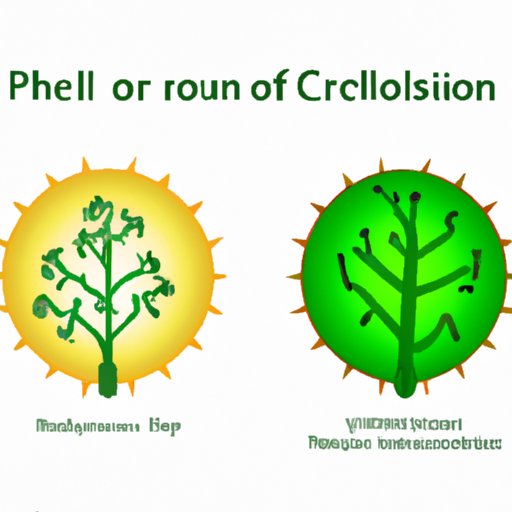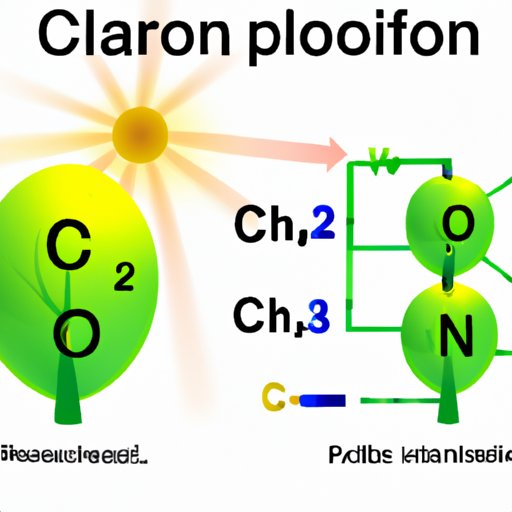Introduction
Photosynthesis and cellular respiration are two core biological processes required to sustain life. Photosynthesis is a process by which plants, algae, and some bacteria convert light energy, carbon dioxide, and water into glucose and oxygen. On the other hand, cellular respiration is a process by which cells obtain energy by breaking down glucose and oxygen into carbon dioxide, water, and ATP. Understanding the relationship between these two processes is crucial to appreciate how living organisms thrive.
The Essential Link between Photosynthesis and Cellular Respiration
Photosynthesis and cellular respiration have a vital and unique relationship because they have complementary outputs and inputs. Photosynthesis produces glucose and oxygen from carbon dioxide and water, while cellular respiration breaks down glucose and oxygen to produce carbon dioxide, water, and ATP. Therefore, photosynthesis outputs are cellular respiration inputs, and vice versa. The two processes must work together to maintain the flow of oxygen and carbon dioxide that living organisms depend on to survive.
Exploring the Interconnected Processes of Photosynthesis and Cellular Respiration
Both photosynthesis and cellular respiration have distinct processes that support their functions. Photosynthesis occurs in two key stages: the light-dependent reactions and the light-independent reactions. The light-dependent reactions occur in the chloroplast’s thylakoid membrane, wherein light energy is converted into chemical energy in order to generate ATP and NADPH molecules. During the light-independent reactions, also known as the Calvin cycle, ATP and NADPH are used to convert carbon dioxide into glucose.
As for cellular respiration, it occurs in three distinct stages: glycolysis, the Krebs cycle, and the electron transport chain. Glycolysis occurs in the cytoplasm, which breaks glucose into two pyruvate molecules. The Krebs cycle takes place in the mitochondria and breaks down the pyruvate molecules into ATP and carbon dioxide. Lastly, the electron transport chain, which is also in the mitochondria, generates ATP from the NADH and FADH molecules deriving from the Krebs cycle.

Photosynthesis and Cellular Respiration: Two Sides of the Same Coin
The relationship between photosynthesis and cellular respiration is evident when we look at how their products are the starting materials for each other. The glucose and oxygen produced during photosynthesis are used as the starting materials for cellular respiration. In contrast, the carbon dioxide and water produced by cellular respiration are essential for photosynthesis.
This site of glucose and oxygen from photosynthesis gives us the energy we need for our daily lives. It is a source of either direct or indirect energy for almost all living organisms on Earth. On the other hand, the products of cellular respiration, such as water and carbon dioxide, are required to support photosynthesis of plant life that is sustaining to both terrestrial and aquatic life forms.
Understanding the Mutual Relationship of Photosynthesis and Cellular Respiration
Photosynthesis and cellular respiration have maintained a balance in the Earth’s atmosphere over millions of years. However, human activities such as industrialization and deforestation have resulted in an imbalance, leading to increases in carbon dioxide levels and a decrease in oxygen levels. This highlights how critical the mutual relationship between the two processes is and that changes in this relationship can have severe environmental impacts
How Photosynthesis and Cellular Respiration Keep the Circle of Life Spinning
Photosynthesis is the process that enables plants and other photosynthetic organisms to produce food from the sunlight. This process forms the foundation of the food chain and sustains the life of herbivores and omnivores alike. The plant matter and sugars created from photosynthesis are the primary energy source for these animals.
Cellular respiration, on the other hand, allows for the efficient and effective use of energy at the cellular level. With the continuous production of ATP molecules, this process is necessary to help us migrate, metabolize and eliminate waste.
The Intricate Dance of Photosynthesis and Cellular Respiration: A Comprehensive Guide
Photosynthesis and cellular respiration are two powerhouses that sustain life on our planet. Photosynthesis releases oxygen and sugar that cells can utilize to generate energy in an efficient and effective manner. Cellular respiration, in turn, produces carbon dioxide, which plants use to produce sugar in a perpetual cycle of life. By understanding these processes and the delicate balance that exists between them, we can appreciate the significance of the interconnectedness of all things.
Conclusion
Photosynthesis and cellular respiration are two unique biological processes that keep the circle of life spinning. They have a complementary relationship, working in tandem to maintain the flow of oxygen and carbon dioxide required for all living organisms to survive. Understanding the relationship between these two processes helps us to appreciate how life has sustained on our planet for million years.
By taking the time to learn more about photosynthesis and cellular respiration, we can start to think about how our daily practices impact the processes and ultimately the planet we call home.
